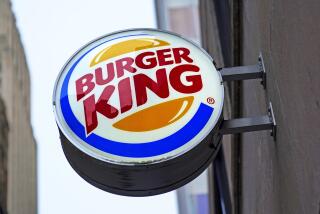New Food Labels May Take a While to Digest : Health: There will be no more touting corn flakes as having âno cholesterolâ when they never had any to begin with. But shoppers may have to do some homework before they do the marketing.
Anew world of food labeling is upon us, and supermarket shoppers are about to boldly go where no consumer has gone before.
Under the first major new regulations in 20 years, those venturing into markets in 1993 will find more stringent--and truthful--claims, with healthful eating the priority. For example:
* No more touting corn flakes as having âno cholesterolâ when it never had any cholesterol to begin with.
* No more listing of thiamine, riboflavin and other obscure nutrients that are no longer deficient in most Americansâ diets.
* No more calling an ice cream sandwich bar âlow fatâ when what the manufacturer is referring to is the substitute ice cream center--while the high-fat chocolate outer coating is ignored.
* No more saying âcontains oat branâ without listing the actual amount of fiber and whether that amount constitutes a significant portion of the recommended daily intake of fiber.
* No more saying one-eighth of a cake has only 130 calories and three grams of fat while ignoring the fact that after you add margarine and milk and make the cake, one-eighth has more than 200 calories and 10 grams of fat.
âI think that consumers are finally going to get some honesty,â says Jeanne Polak, a professor of nutrition at Los Angeles Valley College who was among the experts who advised the Food and Drug Administration on the new food labels. âThere are so many misleading factors in labeling.â
In 1973, the government decided to use food labels to impart nutritional information to consumers. Before then, labels were used to assure consumers that manufacturers were keeping harmful ingredients--like formaldehyde--out of food.
Although the new labels wonât be easy to comprehend, eventually they should clear up confusion in the grocery aisles.
âItâs going to take some education to understand it; there is a lot of information on this label,â says Mary Felando, a registered dietitian and American Heart Assn. volunteer who was also an adviser on the new labels. âBut weâve been allowed to consume foods not knowing what they contain. So itâs wonderful for people who want to eat more healthfully.â
The new law mandates that all processed foods--257,000 products--must comply. While manufacturers have until May, 1994, to make the changes, many are expected to phase in the new labels within months.
Producers of raw meat and poultry will comply with a similar set of guidelines set by the USDA. And nutritional information for many raw fruits and vegetables also will be available in stores.
Only 60% of food products are labeled now, says Ed Scarbrough, director of the FDAâs office of food labeling. âAnd the ones that havenât had it in the past are ones that generally havenât had a good nutrition story to tell.â
The new labels will look very different from previous ones: Instead of listing the calories, followed by a list of vitamins and minerals, they will tell you what is most important regarding your health.
For example, the labels must list total calories, calories from fat, total fat, saturated fat, cholesterol, sodium, total carbohydrates, dietary fiber, sugars, protein, vitamin A, vitamin C, calcium and iron.
Americans simply donât need to worry any more about some minor nutrients, like Vitamin K and zinc, experts say.
âWe are not a country that is not eating enough vitamins and minerals,â says Felando. âWe are a country suffering the problems of overconsumption.â
Also new--and potentially most difficult to understand--is a part of the label called â% Daily Value,â designed to help consumers tally their servings over the course of the day. The new label would tell not only how many grams of fat are in a serving, but also how much that serving will contribute toward their total daily intake of fat.
For example, a food with 140 milligrams of sodium per serving could be mistaken for a high amount. Actually, the â% Daily Valueâ will show that that amount represents less than 6% of the recommended maximum daily intake of sodium, which is 2,400 milligrams (mg).
Polak says she fears all these grams and percentages will intimidate consumers and make them reluctant to use the labels.
âThis information wonât always be clear to the public,â she says. âMost people donât know what a gram is. How many people know how to do percentages? These are not easy concepts for some people. Iâm a pragmatist when it comes to the consumer. It has to be easy.â
But the â% Daily Valueâ is important to tell consumers whether they are eating a little or a lot of a particular nutrient, Felando argues.
âItâs complicated, and thatâs why we have to hope the government follows this labeling plan with a good education plan,â she says.
According to Scarbrough, the government recognizes that an education program will have to accompany the new labels. But so far the program is in the early planning stages, and Scarbrough admits the budget for education is small.
In the meantime, for consumers who donât want to wade through all the numbers on the new labels, experts suggest focusing on a few things, such as the total fat and sodium ratios. Both should have low percentages, Polak says.
Also, look for high percentages of the four nutrients Vitamin A, Vitamin C, iron and calcium.
You wonât find any food thatâs perfect. But, Felando says, âThis will give you a feeling for the (nutritional value) of the food.â
Although figuring out the labels may require some work, consumers will benefit from other changes without having to pull out their calculators.
The new regulations force manufacturers to conform to a standard serving size, and that size will be based on studies that show how much of a food people actually eat. Before, the serving size was up to the discretion of the manufacturer and was much abused.
âOne of the areas where manufacturers could really pull the wool over consumersâ eyes is determining serving size,â Felando says.
For example, a manufacturer could call one-third of a cup of frozen yogurt a serving size--listing the calories and fat for that serving size--when most people would eat three times that amount.
Or, Felando says, âFive tiny crackers would be called a serving size. That is how manufacturers could keep saying their products were low-fat.â
The new label will require cookie makers, for example, to adhere to a standard serving size of 30 grams. The manufacturer also has to list just how many cookies that is.
How manufacturers can tout their products on packaging will radically change: Descriptions such as âlow,â âleanâ or âreducedâ will have to adhere to specific definitions. And to make more elaborate claims regarding nutrition and disease, manufacturers must adhere to strict criteria.
âLow,â as in âlow in calories,â will mean the food could be eaten frequently without exceeding dietary guidelines. For example, âlow sodiumâ would mean less than 140 mg. per serving. But an adult could eat 2,400 mg. of sodium a day before exceeding dietary guidelines.
âReduced,â as in âreduced-cholesterol Cheddar cheese,â will mean that a product has been nutritionally altered to contain 25% less of a nutrient or calories than the regular product, such as regular Cheddar cheese.
âGood source,â as in âgood source of fiber,â means that one serving contains 10% to 19% of the Daily Value for a particular nutrient.
Nutritionists, however, say they are dismayed by the governmentâs decision to allow âlightâ to mean fewer calories, sodium or fat and still be used to explain texture or color, such as âlight and fluffy.â
Nevertheless, the new rules will do much good, particularly in forcing âlow-fatâ claims from many products, Felando says. For example, she says, many âlow-fatâ cheeses now contain four to seven grams of fat. Under the new definition, they must contain no more than three grams to qualify for the âlow-fatâ descriptor.
âMost of the (current) cheeses wonât fit this definition,â Felando says. âMost manufacturers will try to make cheese with less fat. So the consumer wins in the end.â
Indeed, rather than change the eye-catching description on the label, manufacturers may try to change the product, Scarbrough agrees.
âA theory of nutrition labeling is that if a manufacturer has to declare the amount of fat in a product, the incentive is to make that as small as possible,â he says. âWe believe the labeling will have a beneficial effect of manufacturers looking at the product and saying, âCan I take some of the fat or sodium out and not lose the taste?â â
The New Food Label
Serving sizes will be more consistent across product lines and reflect amounts people actually eat.
Calories from fat will be provided to help consumers meet dietary guidelines that say people should get no more than 30% of calories from fat.
Daily Value will show how a food fits into the overall daily diet.
The list of nutrients will include those most important to good health. The list will help consumers avoid getting too much fat, for example, rather than too few vitamins and minerals.
Nutrition Facts
Serving Size: 1/2 cup (114g) Servings Per Container: 4 Amount Per Serving Calories: 90 Calories From Fat: 30 % Daily Value Total Fat 3g: 5% Saturated Fat 0g: 0% Cholesterol 0mg: 0% Sodium 300mg: 13% Total Carbohydrate 13g: 4% Dietary Fiber 3g: 12% Sugars 3g Protein 3g Vitamin A--80% Vitamin C--60% Calcium--4% Iron--4% * This label is only a sample. Source: Food & Drug Administration, 1992
More to Read
Eat your way across L.A.
Get our weekly Tasting Notes newsletter for reviews, news and more.
You may occasionally receive promotional content from the Los Angeles Times.










